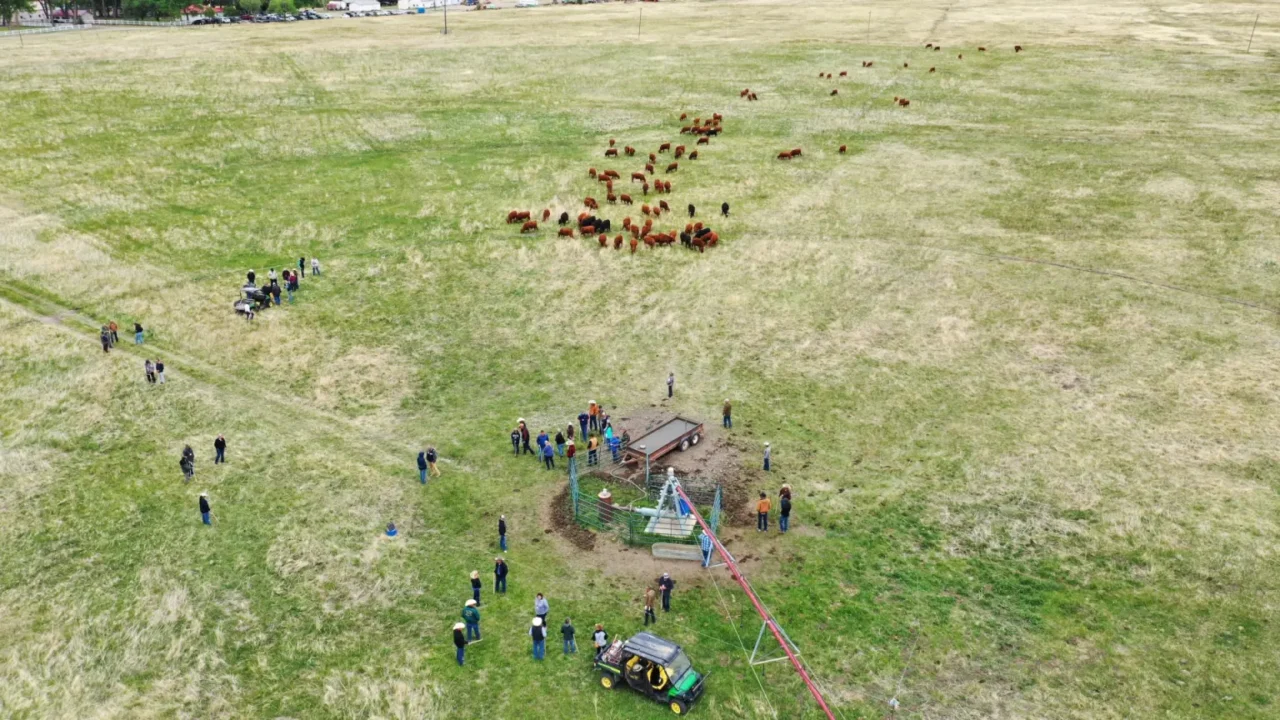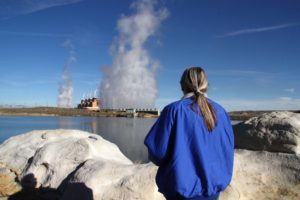How Much Carbon Can Farm Soil Store? Nobody Knows
Advocates say the long-awaited farm bill could help fix that. Ranchers in New Mexico learn about soil health and “regenerative” grazing, which has been touted as a way to store carbon in the ground. Mario Tama / Getty Images via Grist
Ranchers in New Mexico learn about soil health and “regenerative” grazing, which has been touted as a way to store carbon in the ground. Mario Tama / Getty Images via Grist
This story was originally published by Grist. Sign up for Grist’s weekly newsletter here.
Dirt, it turns out, isn’t just worm poop. It’s also a humongous receptacle of carbon, some 2.5 trillion tons of it — three times more than all the carbon in the atmosphere.
That’s why if you ask a climate wonk about the U.S. farm bill — the broad, trillion-dollar spending package Congress is supposed to pass this year (after failing to do so last year) — they’ll probably tell you something about the stuff beneath your feet. The bill to fund agricultural and food programs could put a dent in the country’s greenhouse gas emissions, some environmental advocates say, if it does one thing in particular: Help farmers store carbon in their soil.
The problem is, no one really knows how much carbon farmers can store in their soil.
“There’s still a ton of research that’s needed,” said Cristel Zoebisch, who analyzes federal agriculture policy at Carbon180, a nonprofit that promotes carbon removal.
If America’s growers and herders made sure the carbon on their land stayed underneath their crops and their cows’ hooves, then some scientists say the planet would warm quite a bit less.
Farmers and ranchers interact with carbon more than you might think. Draining a bog to plant rows of soybeans, for example, unleashes a lot of carbon into the air, while planting rows of shrubs and trees on a farm — a practice called alley cropping — does just the opposite, pulling the element out of the air and putting it into the earth. If America’s growers and herders made sure the carbon on their land stayed underneath their crops and their cows’ hooves, then some scientists say the planet would warm quite a bit less. After all, agriculture accounts for some 10 percent of the United States’ greenhouse gas emissions.
“We’re really good at producing a lot of corn, a lot of soybeans, a lot of agricultural commodities,” Zoebisch said, but farmers’ gains in productivity have come at the expense of soil carbon. “That’s something we can start to fix in the farm bill.”
For more than a year, climate advocates have been eyeing the bill as an opportunity to increase funding and training for farmers who want to adopt “climate smart” practices. According to the Department of Agriculture, that label can apply to a range of methods, such as planting cover crops like rye or clover after a harvest or limiting how much a field gets tilled. Corn farmers can be carbon farmers, too.
But experts say the reality is a bit more opaque. There’s still a lot that scientists don’t know about how dirt works, and they disagree about the amount of carbon that farmers can realistically remove from the air and lock up in their fields.
Zoebisch and other advocates say that for the farm bill to be a true success, it’ll have to go even further than incentivizing carbon farming. Congress, they say, should also fund researchers to verify that those practices are, in fact, removing carbon from the atmosphere.
Right now, there’s pretty much no good way for a farmer to know how much carbon they’re storing on their land. Current techniques for sampling soil and measuring carbon levels are really expensive and require equipment that’s hard to use, Zoebisch said. It’s a lot more complicated than sending buckets of dirt to a room full of scientists. Researchers need to drill more than a foot deep into the ground and exhume a ‘core’ that has to be handled with care to avoid compacting or disturbing the soil on its way to a lab.
“There are so many points where errors could be introduced,” Zoebisch said.
Several companies are trying to make the process easier and cheaper, but new technologies haven’t scaled up yet. Beyond taking physical measurements, the USDA uses a model to estimate levels of soil carbon that’s based on severely limited data, and its projections are highly uncertain, so that it’s pretty much useless at the local level, said Jonathan Sanderman, a soil scientist and carbon program director at the Woodwell Climate Research Center in Massachusetts. “You can’t really tell a farmer, ‘This is the exact benefit.’”
Scientists largely agree that cover crops help sequester some amount of carbon, but just how much is up for debate, and it varies by geography, soil type, and numerous other factors. Planting cover crops in fertile Iowa might not have the same effect as planting them in the sandy soils of Southern California.
“There is uncertainty in the literature, but from a first-principles standpoint it makes sense that cover crops should gain carbon, because you’re capturing CO2 out of the atmosphere — a couple tons per hectare — that you wouldn’t have captured” otherwise, Sanderman said. “It’s the nuance we don’t understand.”
Timothy Searchinger, an agriculture and forestry researcher at Princeton University and the World Resources Institute, said he’s a fan of cover crops because they prevent precious topsoil from getting washed or blown away and nitrogen from polluting rivers and streams, but he thinks their potential climate benefits — and those of other practices like reducing tillage — are often exaggerated. Rather than fixate on soil carbon, he said the farm bill should focus on making agriculture more efficient. Helping farmers produce more food on existing farmland could save carbon-rich forests and peatlands from being cleared to meet demand for crops and livestock.
Zoebisch and others want to see funding for soil carbon research made permanent in the farm bill.
Still, Searchinger acknowledged there might be at least a little potential to store carbon on agricultural lands, and said he didn’t want the USDA to stop assisting farmers who want to plant cover crops or try out other climate-smart practices.
Congress allocated almost $20 billion through the Inflation Reduction Act in 2022 to programs that do just that. Some $300 million of it is going to the USDA to ramp up efforts over the coming years to measure carbon in the soil. Currently, the agency draws on long-term data from only 50 sites across the country, Sanderman said. The Inflation Reduction Act funding could increase that number to several thousand.
That money was “an incredible first investment,” Zoebisch said. “This is going to be great for the next four years of funding. But then what happens after that?” Zoebisch and others want to see funding for soil carbon research made permanent in the farm bill.
Fulfilling that wish — and the many others held by climate advocates — hinges most of all on a divided Congress’ ability to reach an agreement. The farm bill expired at the end of September, when lawmakers were busy fighting over other things, like how to avoid a government shutdown and who should (or shouldn’t) be Speaker of the House. So instead of agreeing on a new bill, they extended the old one by a year.
The extension kept money temporarily flowing to programs that prop up farmers and assist families in need of food. It didn’t, however, do anything to tackle climate change or advance anyone’s understanding of how much carbon is in the mush of decaying plants, bacteria, fungi, and worm poop beneath your feet.
Your support matters…Independent journalism is under threat and overshadowed by heavily funded mainstream media.
You can help level the playing field. Become a member.
Your tax-deductible contribution keeps us digging beneath the headlines to give you thought-provoking, investigative reporting and analysis that unearths what's really happening- without compromise.
Give today to support our courageous, independent journalists.






You need to be a supporter to comment.
There are currently no responses to this article.
Be the first to respond.